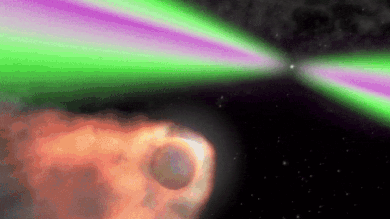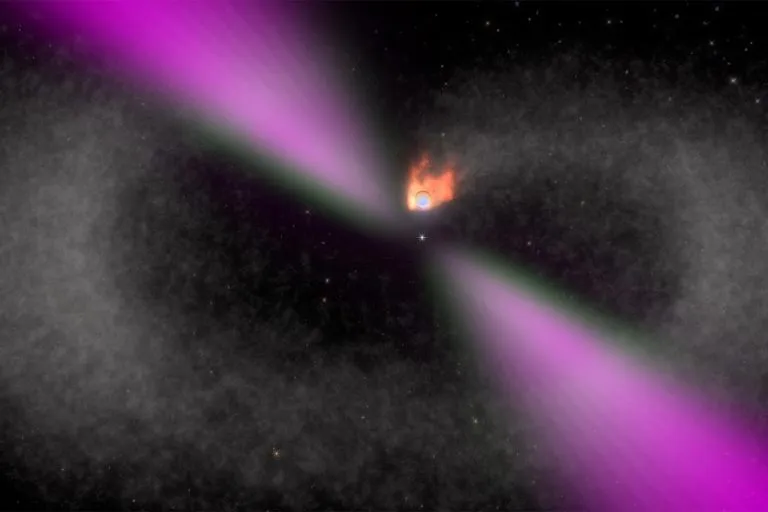According to a new study, the flicker of a star near has attracted astronomers at the Massachusetts Institute of Technology (MIT) to study a new mysterious system 3000 light-years from earth** This strange star seems to be a new "black widow binary" - a fast rotating neutron star or pulsar, which is slowly devouring a smaller companion star, just as arachnids do to their partners.

According to astronomers, there are about 20 "black widow binaries" in the Milky way. The latest candidate star is named ztf j1406 + 1222. Its orbital period is the shortest of all stars found so far. Pulsars and companion stars orbit each other every 62 minutes. This system is particularly unusual because it seems to host a third distant star, orbiting two inner stars every 10000 years.
This possible "black widow" Samsung The system is raising the question of how such a system is formed. Based on its observations, MIT's team came up with an origin story. Like most black widow binaries, the three-star system may come from a dense old star constellation called globular clusters. This particular cluster may have drifted to the center of the Milky Way galaxy, where the gravity of the central black hole is enough to pull the cluster apart and retain the black widow Samsung system.
"This is a complex birth scenario," said Kevin Burge, a postdoctoral researcher in the Department of physics at MIT. "This system may have been floating in the Milky way for longer than the sun."
Burge was published in [Nature] on May 4( https://www.nature.com/articles/s41586-022-04551-1 ) 》The author of a study in the journal detailing the team's findings. The researchers used a new method to test the Samsung system. Although most of the "black widow binaries" were found through gamma and X-ray radiation from the central pulsar, the research team used visible light, especially the flash from the companion stars of the binaries, to detect ztf j1406 + 1222.
"As far as black widow is concerned, this system is really unique because we found it in visible light, because its companion star is wide and it comes from the center of the Milky Way galaxy. There are still a lot of things we don't know about it. But we have a new way to find these systems in the sky," Burge said
The study's co authors are collaborators from multiple institutions, including Warwick University, California Institute of technology, the University of Washington, McGill University and the University of Maryland.
The black widow binary is powered by pulsar, a fast rotating neutron star, which is the core of the collapse of massive stars. Pulsars have a dazzling rotation cycle, rotating once every few milliseconds, and emitting high-energy gamma and X-rays in the process.

Usually, pulsars will rotate rapidly and die after burning a lot of energy. But every once in a while, a passing star will bring new life to the pulsar. When a star approaches, the pulsar's gravity pulls matter down from the star, which provides new energy for the pulsar's rotation. Then the "recovered" pulsar begins to radiate energy again, further peel off the star, and finally destroy it.
"These systems are called black widows because how a pulsar consumes and recycles its stuff is like a spider eating its mate," Burge said
So far, every "black widow binary" system has been detected by pulsar gamma ray and X-ray scintillation. For the first time, Burge discovered ztf j1406 + 1222 through the optical scintillation of the companion star.
It turns out that the daytime side of the companion star - the side that always faces the pulsar - may be many times hotter than its night side because it constantly receives high-energy radiation from the pulsar.
"I think instead of looking directly for a pulsar, try to find the star it's swallowing," Burge explained.
He reasoned that if astronomers observed a star with large periodic changes in brightness, it would be a strong signal that it formed a binary with a pulsar.
Stellar motion
To test this theory, Burge and his colleagues looked at optical data taken by the zwicki transient facility, an observatory in California that can take wide-field images of the night sky. The team studied the brightness of stars to see if any stars changed dramatically 10 times or more in about an hour or less - signs of a companion star orbiting closely around the pulsar.
The team was able to select more than a dozen known "black widow binaries" to verify the accuracy of the new method. Then they found a star whose brightness changed by 13 times every 62 minutes, indicating that it may be part of a new "black widow binary", which they labeled ztf j1406 + 1222.
They found the star in the observation of Gaia space telescope, a space telescope operated by the European Space Agency, which accurately measures the position and motion of stars in the sky. By reviewing Sloan Digital day [air conditioning] decades ago( ?site_id=242986&euid=&t=https%3A%2F%2Flist.jd.com%2Flist.html%3Fcat%3D737%2C794%2C870%26ev%3D1554_584894%26JL%3D3_%25E7%25A9%25BA%25E8%25B0%2583%25E7%25B1%25BB%25E5%2588%25AB_%25E7%25AB%258B%25E6%259F%259C%25E5%25BC%258F%25E7%25A9%25BA%25E8%25B0%2583%23J_crumbsBar ) Looking at the measurements of the star, the team found that the binary star was tracked by another distant star. According to their calculations, the third star seems to orbit the inner binary every 10000 years.
Strangely, astronomers did not directly detect the gamma or X-ray emission of pulsars in binaries, which is a typical way to confirm the "black widow". Therefore, ztf j1406 + 1222 is considered a candidate "black widow binary", and the team hopes to confirm it through future observations.
"One thing we're sure of is that we see a star that's much hotter during the day than at night, orbiting something every 62 minutes. Everything seems to point to it as a black widow binary. But there's something strange about it, so it could be something new," Burge said
The team plans to continue to observe the new system and apply optical technology to illuminate more neutron stars and "black widows" in the sky.
